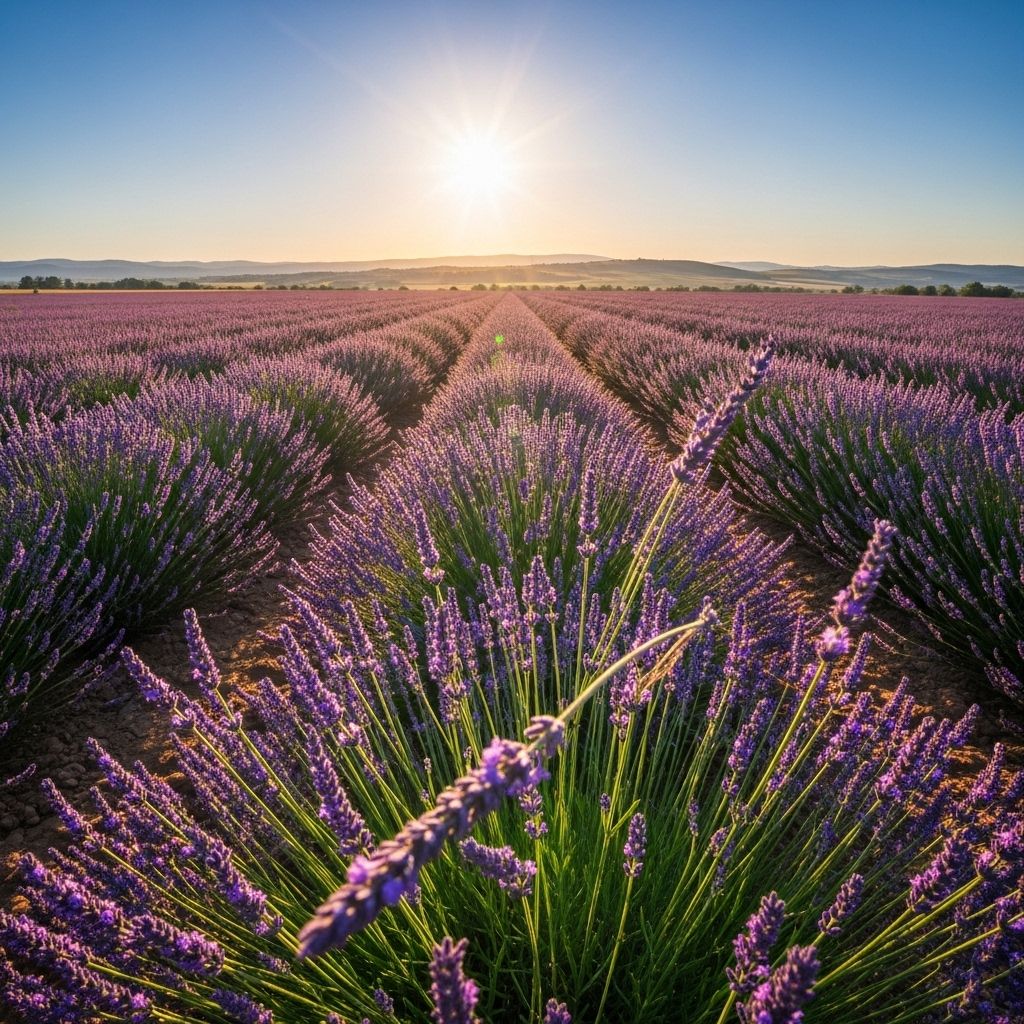How Much Sun Does Lavender Need: Complete Guide For Gardeners
Discover the optimal sun exposure for growing healthy, fragrant lavender plants.

Image: HearthJunction Design Team
Does Lavender Need Full Sun, Partial Shade, or Full Shade?
There is nothing quite like the experience of stepping into a spring garden infused with the sweet fragrance of blooming lavender. This perennial favorite not only charms humans but is also a magnet for bees and other pollinators. Lavender has a rich history, having been used in perfumes, recipes, cleaning supplies, and herbal remedies for thousands of years. Its calming scent makes it a coveted plant not just for its beauty but also for its versatile uses.
The Short Answer
Lavender plants thrive in full sunlight and are not well-suited to shade. They require at least 6 hours of direct sunlight per day, and ideally 8–10 hours during the growing season. While a bit of afternoon shade can be helpful in very hot southern climates, regular partial or full shade will slow lavender’s growth and significantly reduce flower production. For those growing lavender specifically for its coveted scent, direct sunshine is essential, as hot, sunny weather encourages the production of essential oils in the flowers. Additionally, in wet or humid regions, ample sunlight is crucial to keep the foliage dry and prevent disease.
Why Lavender Thrives in the Sun
Lavender is native to the Mediterranean, where it is accustomed to hot, sunny, and dry conditions. This explains why lavender performs best when it receives abundant sunlight. The plant’s growth, flowering, and the quality of its essential oils are all enhanced by long hours of direct light. Sunlight also helps lavender to stay dry, which is vital for preventing fungal diseases, especially in more humid climates.
Lavender’s Light Requirements Explained
- Full Sun: Lavender’s preferred condition. Full sun means at least 6 hours of direct sunlight, but for best results, aim for 8–10 hours.
- Partial Sun/Partial Shade: Lavender can survive in partial sun (less than 6 hours) but will not thrive. Growth may be stunted, and blooming will be reduced.
- Full Shade: Lavender does not do well in full shade. Plants may become leggy, produce few flowers, and be more susceptible to disease.
Tips for Growing Lavender in Different Climates
While lavender prefers full sun, gardeners in different climates may need to make adjustments:
Hot Southern Climates
In regions with intense summer heat, providing some afternoon shade can prevent leaf scorch and help the plant conserve moisture. However, the morning sun should still be strong and direct.
Cooler Northern Climates
In cooler regions, maximizing sunlight exposure is essential. Lavender may not survive harsh winters, but ample sun during the growing season will help it flourish. Consider planting lavender in south-facing locations or using raised beds to improve drainage and warmth.
Soil and Water Requirements
Lavender’s need for sunlight is closely tied to its soil and water preferences:
- Well-Draining Soil: Lavender roots are prone to rot if left in soggy soil. Amend heavy soils with sand or gravel to improve drainage.
- Infrequent Watering: Once established, lavender is drought-tolerant and prefers to dry out between waterings. Overwatering is a common cause of failure, especially in containers.
- Mulching: If mulching is used, opt for a thin layer of inorganic mulch like gravel, which helps keep the soil dry and mimics the plant’s natural Mediterranean habitat.
Growing Lavender in Containers
Lavender adapts well to container gardening, offering flexibility for urban gardeners or those with limited space. When growing in pots:
- Portability: Containers allow you to move your lavender indoors during extreme weather, such as heavy rains or frost, protecting it from adverse conditions.
- Sunlight Management: Place containers in the sunniest spot available—preferably a south-facing window if brought indoors. Supplement with grow lights if necessary.
- Watering Care: Be especially careful not to overwater, as containers can retain moisture and promote root rot. Let the soil dry out between waterings.
How to Maximize Lavender’s Benefits
To get the most from your lavender plant, consider these additional tips:
- Pruning: Regular pruning encourages bushy growth and prevents the plant from becoming woody. Prune after flowering to maintain shape and health.
- Harvesting: For best results, harvest lavender in the morning when flower spikes are partially to fully open. This timing helps preserve the essential oils and fragrance.
- Uses: Lavender is excellent for culinary, aromatic, and medicinal purposes. Dried flowers can be used in sachets, teas, and baked goods.
Common Problems and Solutions
| Problem | Cause | Solution |
|---|---|---|
| Poor Blooming | Insufficient sunlight | Relocate to a sunnier spot |
| Root Rot | Overwatering or poor drainage | Improve soil drainage, water less |
| Leggy Growth | Too much shade | Move to full sun, prune as needed |
| Fungal Diseases | Humid conditions | Ensure good air circulation, avoid overhead watering |
Choosing the Right Lavender Variety
Different lavender varieties have slightly different preferences, but most share similar sun and soil requirements:
- Munstead Lavender: Hardy in USDA zones 5–9, prefers full sun and well-drained soil.
- English Tall (Vera) Lavender: Perennial in zones 5 and warmer, also requires full sun.
- French Lavender: Less cold-hardy, but still sun-loving.
Frequently Asked Questions (FAQs)
Q: Can lavender survive in partial shade?
A: Lavender can survive in partial shade but will not thrive. For best results, provide at least 6 hours of direct sunlight daily.
Q: How much water does lavender need?
A: Lavender is drought-tolerant once established. Water deeply but infrequently, allowing the soil to dry out between waterings.
Q: Can I grow lavender indoors?
A: Yes, lavender can be grown indoors if placed in a south-facing window or under strong grow lights. Ensure good air circulation and avoid overwatering.
Q: Why is my lavender not blooming?
A: The most common causes are insufficient sunlight, overwatering, or improper pruning. Move to a sunnier spot and adjust your care routine.
Q: What type of soil is best for lavender?
A: Lavender prefers well-draining, sandy or gravelly soil with a neutral to slightly alkaline pH.
Q: How do I prune lavender?
A: Prune lightly after flowering to maintain shape and encourage bushy growth. Avoid cutting into old wood, as this can damage the plant.
Conclusion
To cultivate healthy, fragrant lavender, prioritize full sun and well-drained soil. Whether you are growing lavender for its beauty, aroma, or practical uses, meeting these basic needs will ensure your plants thrive. Adjust care based on your climate, and consider container gardening for added flexibility. With these guidelines, you’ll be able to enjoy the many benefits of lavender in your garden for years to come.
References
Read full bio of medha deb












